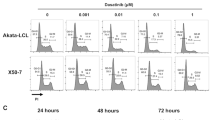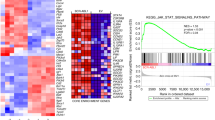Abstract
The Bcr-Abl/p210 fusion protein plays a primary role in the pathogenesis of chronic myelogenous leukemia (CML). Abelson murine leukemia virus, which encodes v-Abl/p160, induces a pre-B cell leukemia/lymphoma in mice. It has been unclear whether the apparent specificity of these two abl oncogenes for myeloid versus lymphoid neoplasms is due to specific intrinsic properties of these Abl oncoproteins, or due to the properties of the target cells expressing them. We have recently shown that expression of Bcr-Abl in bone marrow cells by retroviral transduction efficiently induces a myeloproliferative disorder in mice resembling human CML. In this study, we compared Bcr-Abl/p210 and v-Abl/p160 in this mouse CML model. We found that early in the course of disease, both Bcr-Abl/p210 and v-Abl/p160 expanded early immature hematopoietic cells. Later Bcr-Abl/p210 selectively expanded myeloid cells while v-Abl/p160 primarily induced the rapid in vivo expansion of B lymphoblastic cells, along with a minor population of myeloid cells. In vitro, Bcr-Abl/p210 induced more growth of myeloid colonies from 5-fluorouracil treated bone marrow than v-Abl/p160. These results, obtained under equal bone marrow transduction/transplantation conditions, indicate that Bcr-Abl/p210 has a greater intrinsic capacity than v-Abl/p160 to induce the neoplastic growth of myeloid cells. In addition, we found that cultured cells expressing Bcr-Abl/p210 had more activated STAT5 than cells that expressed v-Abl/p160. This suggests that activation of STAT5 might be one part of the mechanism of abl oncogene disease specificity.
This is a preview of subscription content, access via your institution
Access options
Subscribe to this journal
Receive 50 print issues and online access
$259.00 per year
only $5.18 per issue
Buy this article
- Purchase on Springer Link
- Instant access to full article PDF
Prices may be subject to local taxes which are calculated during checkout





Similar content being viewed by others
References
Akashi K, Traver D, Miyamoto T and Weissman IL. . 2000 Nature 404: 193–197.
Allman D, Li J and Hardy RR. . 1999 J. Exp. Med. 189: 735–740.
Carlesso N, Frank DA and Griffin JD. . 1996 J. Exp. Med. 183: 811–820.
Chai SK, Nichols GL and Rothman P. . 1997 J. Immunol. 159: 4720–4728.
Coligan JE, Kruisbeek AM, Margulies DH, Shevach EM and Strober W. (eds) . 1996 Current Protocols in Immunology. John Wiley and Sons, Inc., New York.
Daley GQ, Van Etten RA and Baltimore D. . 1990 Science 247: 824–830.
Danial NN, Losman JA, Lu T, Yip N, Krishnan K, Krolewski J, Goff SP, Wang JY and Rothman PB. . 1998 Mol. Cell Biol. 18: 6795–6804.
Danial NN, Pernis A and Rothman PB. . 1995 Science 269: 1875–1877.
Elefanty AG and Cory S. . 1992 Mol. Cell. Biol. 12: 1755–1763.
Elefanty AG, Hariharan IK and Cory S. . 1990 EMBO J 9: 1069–1078.
Faderl S, Talpaz M, Estrov Z, O'Brien S, Kurzrock R and Kantarjian HM. . 1999 N. Engl. J. Med. 341: 164–172.
Gross AW, Zhang X and Ren R. . 1999 Mol. Cell. Biol. 19: 6918–6928.
Gurish MF, Pear WS, Stevens RL, Scott ML, Sokol K, Ghildyal N, Webster MJ, Hu X, Austen KF, Baltimore D and Friend DS. . 1995 Immunity 3: 175–186.
Hardy RR, Carmack CE, Shinton SA, Kemp JD and Hayakawa K. . 1991 J. Exp. Med. 173: 1213–1225.
Heisterkamp N, Jenster G, ten Hoeve J, Zovich D, Pattengale PK and Groffen J. . 1990 Nature 344: 251–253.
Honda H, Fujii T, Takatoku M, Mano H, Witte ON, Yazaki Y and Hirai H. . 1995 Blood 85: 2853–2861.
Ilaria Jr RL and Van Etten RA. . 1996 J Biol Chem 271: 31704–31710.
Kelliher MA, McLaughlin J, Witte ON and Rosenberg N. . 1990 Proc. Natl. Acad. Sci. USA 87: 6649–6653.
Kelliher MA, Weckstein DJ, Knott AG, Wortis HH and Rosenberg N. . 1993 Oncogene 8: 1249–1256.
Kieslinger M, Woldman I, Moriggl R, Hofmann J, Marine JC, Ihle JN, Beug H and Decker T. . 2000 Genes. Dev. 14: 232–244.
Kondo M, Weissman IL and Akashi K. . 1997 Cell 91: 661–672.
Li S, Ilaria Jr, RL, Million RP, Daley GQ and Van Etten RA. . 1999 J. Exp. Med. 189: 1399–1412.
Melo JV. . 1996 Blood 88: 2375–2384.
Pear WS, Miller JP, Xu L, Pui JC, Soffer B, Quackenbush RC, Pendergast AM, Bronson R, Aster JC, Scott ML and Baltimore D. . 1998 Blood 92: 3780–3792.
Pear WS, Nolan GP, Scott ML and Baltimore D. . 1993 Proc. Natl. Acad. Sci. USA 90: 8392–8396.
Raitano AB, Whang YE and Sawyers CL. . 1997 Biochim. Biophys. Acta. 1333: F201–F216.
Rosenberg N and Baltimore D. . 1976 J Exp. Med. 143: 1453–1463.
Rosenberg N and Witte ON. . 1988 Adv. Virus Res. 35: 39–81.
Sawyers CL. . 1999 N. Engl. J Med. 340: 1330–1340.
Scott ML, Van Etten RA, Daley GQ and Baltimore D. . 1991 Proc. Natl. Acad. Sci. USA 88: 6506–6510.
Shuai K, Halpern J, ten Hoeve J, Rao X and Sawyers CL. . 1996 Oncogene 13: 247–254.
Socolovsky M, Fallon AE, Wang S, Brugnara C and Lodish HF. . 1999 Cell 98: 181–191.
Verfaillie CM, Hurley R, Lundell BI, Zhao C and Bhatia R. . 1997a Acta. Haematol. 97: 40–52.
Verfaillie CM, Hurley R, Zhao RC, Prosper F, Delforge M and Bhatia R. . 1997b J. Lab. Clin. Med. 129: 584–591.
Voncken JW, Kaartinen V, Pattengale PK, Germeraad WT, Groffen J and Heisterkamp N. . 1995 Blood 86: 4603–4611.
Zhang X and Ren R. . 1998 Blood 92: 3829–3840.
Zou X and Calame K. . 1999 J. Biol. Chem. 274: 18141–18144.
Acknowledgements
We thank Xiaowu Zhang for his assistance, and Ben Hentel and Jonathan Schatz for their help in analysing mice and with flow cytometry. This work was supported by National Cancer Institute grant CA68008 (to R Ren). R Ren is a recipient of The Leukemia and Lymphoma Society Scholar Award.
Author information
Authors and Affiliations
Rights and permissions
About this article
Cite this article
Gross, A., Ren, R. Bcr-Abl has a greater intrinsic capacity than v-Abl to induce the neoplastic expansion of myeloid cells. Oncogene 19, 6286–6296 (2000). https://doi.org/10.1038/sj.onc.1204023
Received:
Revised:
Accepted:
Published:
Issue Date:
DOI: https://doi.org/10.1038/sj.onc.1204023
Keywords
This article is cited by
-
Activation of signaling pathways in models of t(6;9)-acute myeloid leukemia
Annals of Hematology (2022)
-
BCR–ABL1-induced downregulation of WASP in chronic myeloid leukemia involves epigenetic modification and contributes to malignancy
Cell Death & Disease (2017)
-
Molecular and cellular bases of chronic myeloid leukemia
Protein & Cell (2010)
-
Mechanisms of BCR–ABL in the pathogenesis of chronic myelogenous leukaemia
Nature Reviews Cancer (2005)
-
The molecular mechanism of chronic myelogenous leukemia and its therapeutic implications: studies in a murine model
Oncogene (2002)



